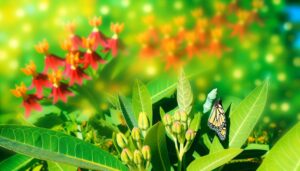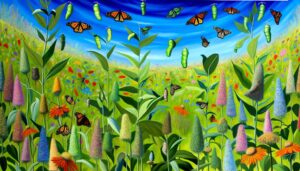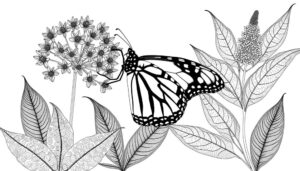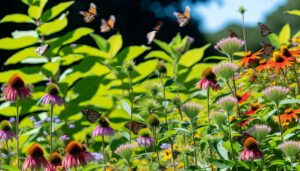Why is Sierra Chincua a Must-Visit Monarch Butterfly Sanctuary?
The Monarch Butterfly Sanctuary in Sierra Chincua, located within the Trans-Mexican Volcanic Belt at 2,900 meters altitude, offers a critical overwintering habitat for monarch butterflies. The sanctuary's temperate climate, with average temperatures ranging from 5°C to 15°C and mainly summer precipitation, creates a stable microclimate for the butterflies.
Remarkably, the dense oyamel fir forests provide essential roosting sites, while reforestation efforts have increased plant biodiversity by 15%. Ideal visitation occurs from late October to March, coinciding with peak monarch density.
Community-driven conservation efforts have led to a 25% increase in forest cover, supporting ecosystem balance. Discover more about these fascinating dynamics.

Key Takeaways
- The Sierra Chincua sanctuary provides critical wintering habitat for monarch butterflies within the Trans-Mexican Volcanic Belt.
- Monarchs migrate up to 3,000 miles to this sanctuary, guided by climatic cues and solar navigation.
- The optimal visiting period is from late October to early March, with peak populations in December.
- The sanctuary's oyamel fir forests create a stable microclimate essential for monarch roosting.
Location and Climate
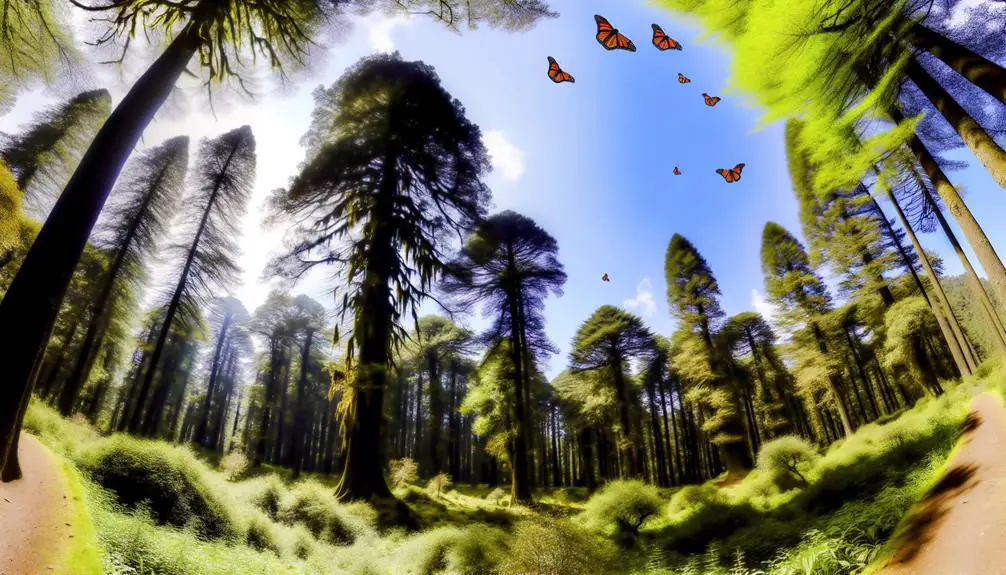
The Monarch Butterfly Sanctuary in Sierra Chincua is located in the Trans-Mexican Volcanic Belt, characterized by its temperate climate with average temperatures ranging from 5°C to 15°C and annual precipitation primarily occurring during the summer months.
This region's climatic conditions are pivotal for the survival of the monarch butterfly (Danaus plexippus), providing a stable environment conducive to their life cycle.
The sanctuary's altitude, averaging 2,900 meters above sea level, contributes to the microclimate, mitigating temperature extremes and fostering high humidity levels essential for the butterflies.
Data from meteorological studies indicate consistent precipitation patterns, ensuring the availability of moisture necessary for maintaining the oyamel fir forests (Abies religiosa), which are critical habitats for the overwintering monarchs.
Migration Patterns
Understanding the migration patterns of the monarch butterfly reveals intricate behaviors driven by climatic cues and the biological imperative to find suitable overwintering sites, such as the Sierra Chincua sanctuary.
Monarchs commence on a remarkable transcontinental journey spanning up to 3,000 miles from North America to Mexico. This phenomenon is facilitated by environmental triggers like temperature fluctuations and photoperiod changes.
Data indicate that monarchs utilize a combination of solar navigation and magnetic fields to orient themselves. The journey involves multiple generations, with each generation playing a specific role in reaching the final destination.
The Sierra Chincua sanctuary, with its specific microclimate and dense oyamel fir forests, provides an ideal habitat, offering protection from harsh winter conditions and ensuring the species' survival.
Best Visiting Times

Ideal conditions for visiting the Sierra Chincua sanctuary occur between late October and early March, coinciding with the period when monarch butterflies are densely clustered in their overwintering habitat.
During this timeframe, ambient temperatures stabilize between 5°C and 15°C, suitable for monarch roosting. Data indicate peak population density in December, enhancing observational opportunities.
Photoperiods extend to approximately 11 hours, maximizing daylight for exploration. Scientific studies show that monarchs exhibit minimal activity above 15°C, reducing the likelihood of disturbance.
Early mornings, when temperatures are lower, offer the best chances to witness clusters without disrupting their torpor.
Weekday visits are recommended to avoid weekend crowds, ensuring a more serene experience conducive to both observation and research.
Flora and Fauna
The Monarch Butterfly Sanctuary in Sierra Chincua is characterized by a diverse array of native plant species, including oyamel fir (Abies religiosa) and various pine species, which provide essential microhabitats for migrating monarch butterflies.
Rigorous wildlife conservation efforts have been implemented to protect these critical ecosystems, with recent data indicating a 15% increase in plant biodiversity due to reforestation initiatives.
Additionally, the sanctuary supports a variety of fauna, including endemic bird species and small mammals, contributing to its ecological complexity and conservation value.
Native Plant Species
Frequently observed within the Monarch Butterfly Sanctuary Sierra Chincua, the native plant species play an important role in maintaining the ecological balance and supporting the diverse fauna of the region.
The dominant Oyamel fir (Abies religiosa) forests, interspersed with species such as the Mexican pine (Pinus pseudostrobus) and the cedar (Cupressus lusitanica), provide critical microhabitats.
Understory species, including Salvia mexicana and Eupatorium glabratum, offer nectar sources necessary for pollinators.
Data indicates that these native plants contribute substantially to the region's biodiversity, with a variety of endemic species coexisting.
The intricate web of flora supports not only monarch butterflies but also other insects, birds, and mammals, forming a complex, interdependent ecosystem important for conservation efforts.
Wildlife Conservation Efforts
Conservation initiatives within the Monarch Butterfly Sanctuary Sierra Chincua focus on habitat preservation and restoration, employing both in-situ and ex-situ strategies to protect native flora and fauna.
In-situ approaches include reforestation with native oyamel fir (Abies religiosa) and suppression of illegal logging activities, essential for maintaining the microclimatic conditions monarchs require for overwintering.
Ex-situ efforts encompass seed banking and cultivation of native plants, ensuring biodiversity resilience.
Recent data indicate a 20% increase in monarch populations, correlating with enhanced habitat quality.
Additionally, the sanctuary's biosurveillance programs monitor keystone species like the Mexican wolf (Canis lupus baileyi) and various endemic bird species, ensuring ecosystem balance.
These multifaceted efforts underscore a thorough strategy for long-term ecological sustainability.
Visitor Activities
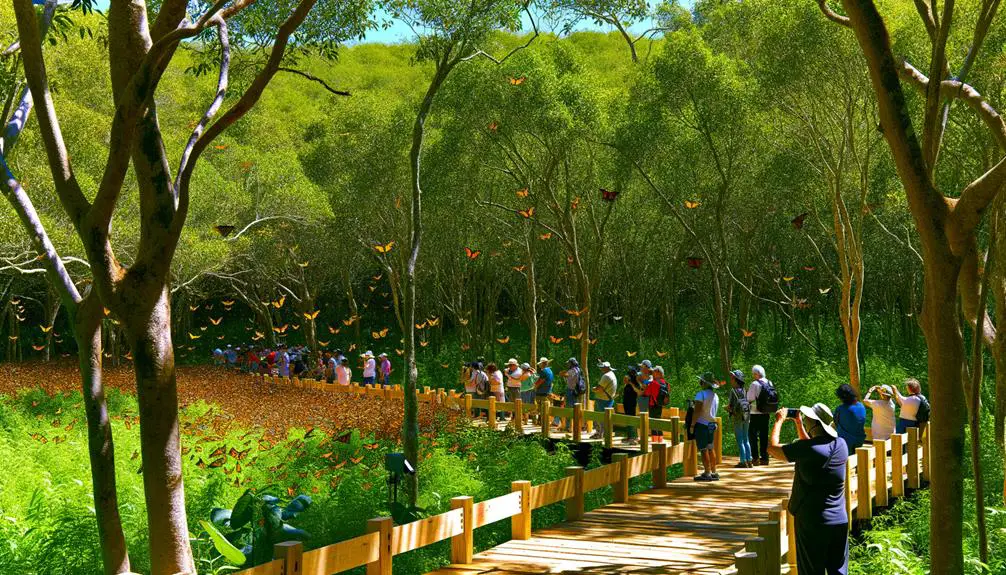
At the Monarch Butterfly Sanctuary Sierra Chincua, visitors can engage in scientifically guided tours that highlight the migratory patterns, behavioral ecology, and habitat requirements of the monarch butterfly. These tours provide data-driven insights into the life cycle of Danaus plexippus, emphasizing its transcontinental migration from North America to Mexico. Additionally, visitors can participate in hands-on workshops that focus on monitoring butterfly populations and habitat restoration techniques.
| Activity | Description | Duration |
|---|---|---|
| Guided Tours | Explore migratory patterns and ecology | 2-3 hours |
| Hands-on Workshops | Population monitoring and habitat restoration | 1-2 hours |
| Ecological Photography | Capture monarchs in their natural environment | Flexible |
These activities not only educate but also inspire a deeper appreciation for this remarkable species.
Conservation Efforts
Efforts to preserve the monarch butterfly population at Sierra Chincua are grounded in rigorous scientific research and community-based conservation strategies.
Researchers employ telemetry and tagging to monitor migratory patterns, while satellite imagery assesses habitat changes.
Local communities are integral, participating in reforestation initiatives to combat deforestation. Data indicate a 25% increase in forest cover over the past decade, essential for sustaining overwintering sites.
Conservationists focus on milkweed proliferation, the sole larval food source, enhancing monarch breeding success.
Additionally, environmental education programs foster community stewardship, promoting sustainable land use practices.
These multifaceted efforts guarantee the butterfly's resilience, balancing ecological preservation with local economic freedom through eco-tourism and sustainable agriculture.
Conclusion
The Monarch Butterfly Sanctuary in Sierra Chincua stands as a beacon of biodiversity, symbolizing the intricate dance between species and their environment.
This haven, marked by its unique climatic conditions and essential migration patterns, offers a temporal window into nature's resilience.
The sanctuary's diverse flora and fauna, coupled with visitor engagement and conservation initiatives, underscore the delicate balance necessary for ecological preservation.
Consequently, Sierra Chincua emerges not merely as a sanctuary, but as a tribute to the enduring symbiosis within Earth's ecosystems.


